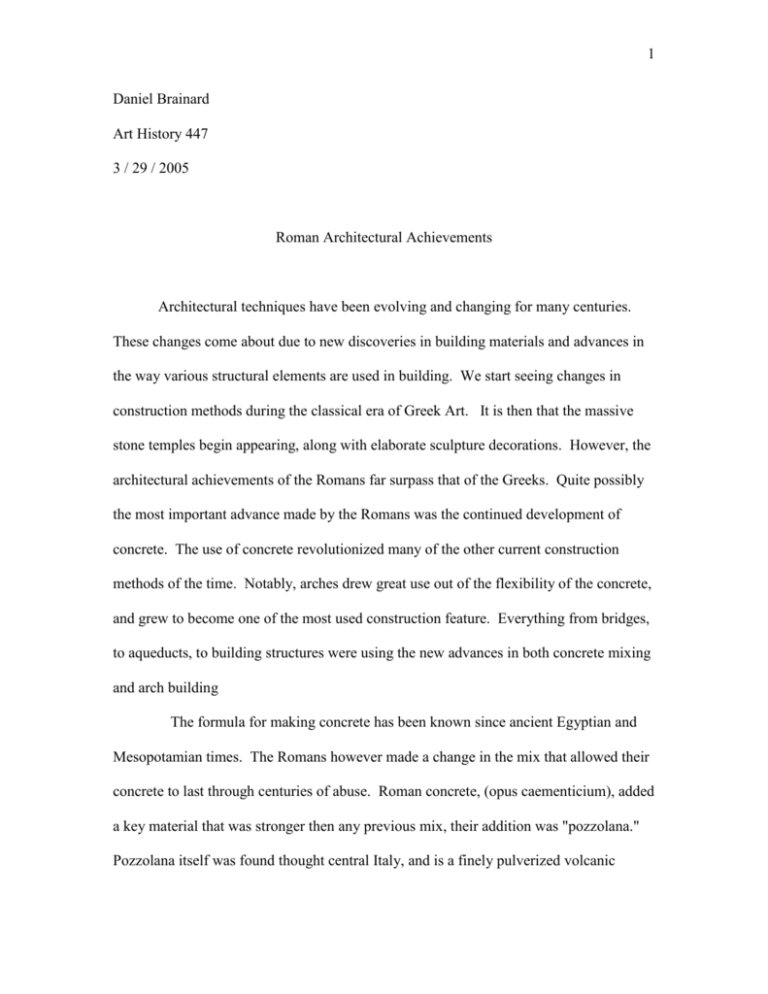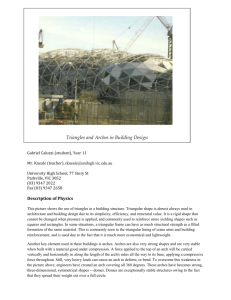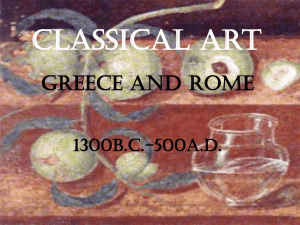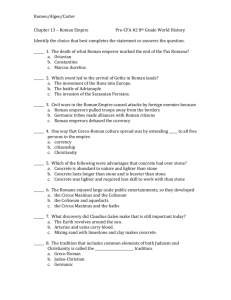Daniel Brainard - Digital Arts @ BGSU
advertisement

1 Daniel Brainard Art History 447 3 / 29 / 2005 Roman Architectural Achievements Architectural techniques have been evolving and changing for many centuries. These changes come about due to new discoveries in building materials and advances in the way various structural elements are used in building. We start seeing changes in construction methods during the classical era of Greek Art. It is then that the massive stone temples begin appearing, along with elaborate sculpture decorations. However, the architectural achievements of the Romans far surpass that of the Greeks. Quite possibly the most important advance made by the Romans was the continued development of concrete. The use of concrete revolutionized many of the other current construction methods of the time. Notably, arches drew great use out of the flexibility of the concrete, and grew to become one of the most used construction feature. Everything from bridges, to aqueducts, to building structures were using the new advances in both concrete mixing and arch building The formula for making concrete has been known since ancient Egyptian and Mesopotamian times. The Romans however made a change in the mix that allowed their concrete to last through centuries of abuse. Roman concrete, (opus caementicium), added a key material that was stronger then any previous mix, their addition was "pozzolana." Pozzolana itself was found thought central Italy, and is a finely pulverized volcanic 2 product which is very hard and can resist wear and abrasion better than the soft lime which bound the pieces of gravel together in regular concrete made only of lime, sand and gravel” (Grant 290). Later it was found that mixing the pozzolana with limestone in a kiln reduced it into “quicklime”, which remained the best know cement material until Portland cement was discovered in the 19th century. The mixture would then be mixed with an aggregate. This aggregate (caementa), was often made of stone chips and other waste rock from broken building faces and when mixed with the pozzolana and lime bound it together in a compact mass that was solid and exerted little thrust when set (Grant 291). There are four main reasons as to why Roman concrete became a huge achievement of the era. First and foremost, the concrete was stronger then any material that had been found to date. This exceptional strength allowed the roman architects to span great distances using new methods which the concrete allowed, such as arches, vaults, and domes. The already strong concrete was also often reinforced. The Romans, who obviously did not have the steel rebar that we use today, instead tested various types of ropes and ceramic rods as reinforcement. The second reason as to why Roman concrete was so important was the fact that it is such and easily workable material. This flexibility is due to the methods with which the concrete was applied and used. Unlike today’s modern methods of pouring concrete, the Romans used a much thicker mix that we would call a “no slump” mixture that was created by keeping the moisture content in the concrete low. They would then lay down the base structure of stones and aggregate and begin forcing the mixture over and into it, creating the solid mass we see. Another advantage this method had was that changes in the construction could be made very easily and at the last minute, which was something that could rarely be done with a 3 building built of carved stone. In addition, concrete is able to set underwater, so its uses with bridges and aqueducts were quite widespread. The third reason for the success of concrete was the low cost and the ease using it. With both key components being easy to obtain materials, the price of using concrete was much lower the other traditional building methods. The aggregate was almost always excess materials from other building projects or waste from structures that were broken or destroyed. In addition to the low cost of the materials themselves, the actual labor itself cost very little, since skilled rock carvers were no longer needed to complete the structures. Concrete was also a much faster material to work with. Architects and construction crews no longer needed to wait months or years for all of the cut stone blocks. The fourth reason, while a somewhat lesser issue was that concrete is obviously fireproof. When used to build both walls and roofs, these structures in effect become much safer then the wooden structures which were used before. The one major downfall of concrete was that once the framework was removed, what remained was a structure of very unsightly rock surface. The Romans however employed several methods with which to cover this surface. The first method used to counter these ugly surfaces was to lay slabs of cut tufa (a semi-soft volcanic rock, found mostly in central Italy) stone as facing, as seen in the picture below. Structures were started with a simple concrete core then the slabs were bound securely to the surface. While this method did indeed work to cover the concrete surface, it required skilled craftsmen and extra time to carve the slabs of tufa. Going back to needing the skilled carvers in many respects defeated the purpose of using the cheap concrete construction in the first place. 4 When it was realized that the tufa slab method was not terribly efficient, the Romans began to experiment with other methods of altering the concrete surface. The next technique used was known as opus incertum. This method took a core structure of concrete and into this would be set cone-shaped pieces of tufa, with the flat, irregularly shaped head of the cone facing outwards (Ramage 64). Opus Testaceum was a method that took rectangular faced bricks, with pointed backsides, and set them into the concrete. The effect of this technique was a finished facing that appeared to be laid of regular bricks. The opus reticulatum method became one of the more popular facing methods which started to be used during the first century BC. This system used the heads of pyramidal stones or bricks which are characterized by a series of diamond shapes that give the effect of a kind of net pattern (Ramage 65). This pattern appears as the flat surfaces of walls between corners of laid brick or stone. According to Vitruvius, opus incertum is an "ancient style," and opus reticulatum, while not as strong, is the "style used by everybody” (Geary 3). Probably the best preserved examples of the opus reticulatum method come from the remains of Hadrian’s Villa. This grand residential 5 area of Tivoli is also well known for mixing various facing methods in order to achieve the most visually pleasing structures. Close up detail of opus reticulatum, Hadrian’s Villa Mixed facing, Hadrian’s Villa In addition to these more basic facings, some of the more wealthy partisans would take it one step farther. After the initial facing was set, it was often times covered with another more decorative material. Frequently this added material was plaster or stucco, which 6 could then be molded and painted to imitate cut marble masonry if so desired. In some cases, privately funded structures with large budgets would even employ the use of actual cut marble slabs. Using thin marble facings, the Romans were able to achieve elegantly carved half pillars among other decorative features. Here we see an example of marble facing that has been laid on top of an Opus Testaceum brick facing. While using these marble slabs again increases labor and price of buildings, it is quite easy to see how much time, labor, and costs could be saved by using a thin marble plaque as opposed to huge cut blocks as the Greeks had done. One disappointing aspect of these extra facing materials is that very few examples still survive. What we see left on most Roman ruins is only the original opus brick facings. The concrete and the bricks have been able to stand the test of time quite well. The plaster, stucco, and marble faces have not had such luck. Much of the plaster and stucco have simply just not been endure the elements, being slowly destroyed. Much of the marble facing suffered a different fate. As buildings were abandoned or destroyed, nearly all expensive materials that might have been in them were taken and reused 7 elsewhere. Not only that but under times of attack, buildings were destroyed and looted of any materials that would be worth anything. The fact that many ancient roman buildings are in the state they are in now often misled people into believing Roman architects left their walls with simple brick facings, rather then making any attempts at elegant design (Grant 293). The next truly great architectural achievement made by the Romans was the successful and inventive use of the arch. While it is sometimes said that the Roman where the designers of the arch, this is not actually the case. The early Etruscans were in fact the first civilization to make use of the arch, the Great Drain (Cloaca Maxima) is one such Etruscan arch that survives today (Grant 295). The arch originated with the idea of placing a considerable number of blocks in a concentric arrangement. The wedge-shaped blocks, called voussoirs, hold each other firmly in place and prevent each other from slipping. The voussoirs at the top, or crown, of the arch convert the downward pressure into lateral outward pressure, or thrust, which is transmitted from the upper voussoirs down around the opening and finally into the ground through the wall or pier on which the arch rests. Not only can considerable distances be spanned in this way, but arches can carry a much heavier load than a horizontal lintel (Arches). In addition to these uses, arches had a tendency to be much cheaper to use then building a solid wall, due to the obvious fact that much less material is needed to hold the upper materials up. Arches however were still not without some weaknesses, especially before concrete was used in the creation of the arches. With a block constructed arch there is a tremendous amount of thrust pushing on the lower voussoirs. If any one of these were to get pushed out of 8 place to far there is a danger of the keystone slipping out, causing the entire arch to collapse. This was countered in a couple of different ways. First, was to place several arches in a line so that the spandrel between the two countered the thrust of the lower voussoirs. However, on a single arch or at the end of a line of arches this option wasn’t viable, so instead there is generally a huge bulk of mass on either side of the arch to counter the thrust. This second method is often seen in triumphal arches. The advent of concrete use in arches served to eliminate many of the weaknesses of block arches. The fact that concrete exerts equal amounts of force though out the structure allowed the arches to become smaller, stronger, and able to span much greater distances. The development and use of the arch is what allowed the Romans to create the great buildings and structures that we still see today. Arches first began seeing excessive use in bridges and aqueducts, and then later started appearing as major structural elements of buildings. Bridges and aqueducts were a very logical next step for the 9 Romans to take with their new arch technology. The ability to span large valleys and rivers easily arched bridges great utility in the mountainous regions of Italy. An example of one such bridge is seen in Narni, where the Via Flaminia crossed the river Nera. The bridge had 4 nearly perfect half circle arches, of which only one still survives today. It is known from looking at the piers that the arches were not all the same height, meaning the central arch spanned a much greater distance then the other three. Another great bridge built by the Romans is located in Alcantra (which means “The Great Bridge”). This amazing bridge spans the Tagus with six great arches, which rise more then two hundred feet above the river. Originally constructed in the year 105 AD, the bridge stood intact until the 13th century when enemy forces destroyed one of the arches. Since then it has undergone two repairs, allowing it to be in continued use to this day. In addition to bridges, the Romans used their arch technology to great prevail while constructing aqueducts. Ancient Rome had eleven major aqueducts, built between 10 312 B.C. (Aqua Appia) and 226 A.D. (Aqua Alexandrina); the longest (Anio Novus) was 59 miles long. It has been calculated that in imperial times, when the city's population was well over a million, the distribution system was able to provide over one cubic meter of water per day for each inhabitant: more than we are accustomed to use nowadays (InfoRoma). While in most cases a good portion of the aqueduct system would be simply bored underground, as Roman building techniques were improved so were the aqueduct systems. The overall goal was to keep a constant gradation from the source of the water, all the way into the city. To do this, the aqueducts started being raised up on large arched runways in order to span valleys and low areas, sometimes rising up to one hundred feet above ground level. The Aqua Claudia pictured below was one of the many aqueducts that used concrete construction, due to its waterproof nature. Not all built using concrete however. The aqueduct at Segovia, which was built during the mid first century AD, is an excellent example. While still constructed using arches, this particular aqueduct was built using no mortar or other binding materials. The granite rocks are precisely carved to fit just into place with each stone below it. 11 It is very easy to see that the architectural advances achieved by the Romans not only benefited them in ancient times, but rather, continued to alter building construction for centuries. The development of Roman concrete is quite possibly one of the greatest discoveries in the architectural world ever. Without it many of the amazing structures we know of today would have never been built. Not to mention that with the development of concrete came advances in other architectural methods as seen with the arch. Arches had been used previously without concrete, but had many more limits on the construction. In addition the continued development of the arch itself is another great achievement. Very few structures left out the use of arches after the usability was realized. 12 Works Cited Arches. Parts of an Arch. http://employees.oneonta.edu/farberas/arth/arth109/arch_vaults.html Geary, Judith. Republican Roman Construction. 2000. Appalachian State University. http://romanhistorybooksandmore.freeservers.com/l_rrc1.html Grant ,Michael. The World of Rome. NY: Penguin Group 1960 InfoRoma. Roman Aqueducts. http://www.inforoma.it/feature.php?lookup=aqueduct Ramage, Nancy, and Andrew Ramage. Roman Art. New Jersey: Prentice Hall. 2005







